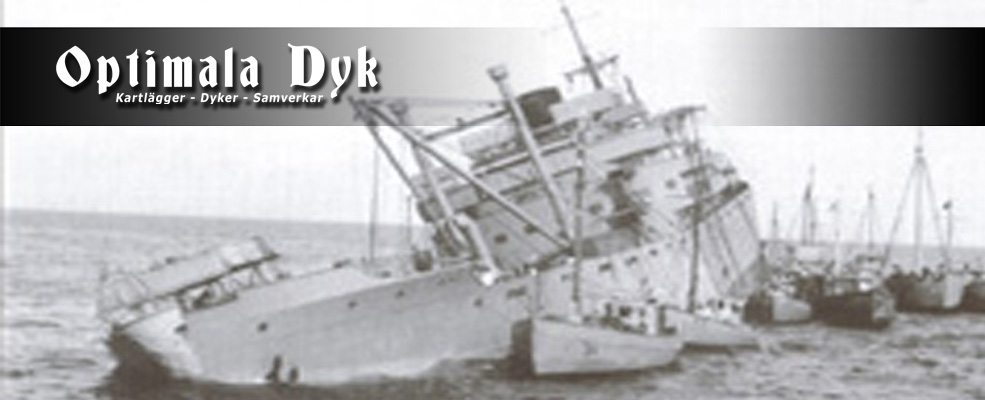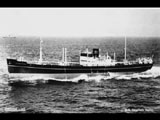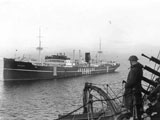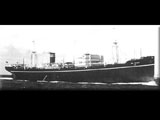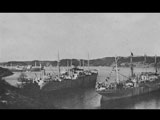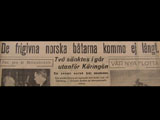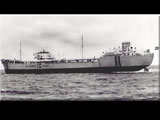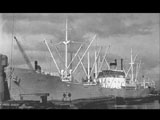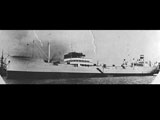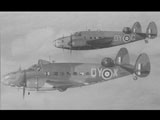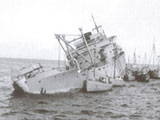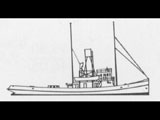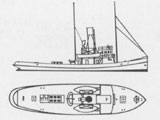War in the Kattegat 1939-1945.
A article in seven parts.
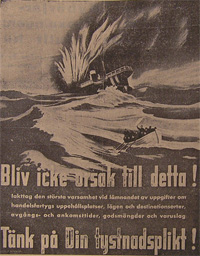
Part 4: 1942
During the spring of 1942, the British bombings against Germany increased. In 1942, German and British courier flights continued over Swedish territory. During the so-called February crisis, when a German attack on Sweden was feared, all available air defences were mobilized and, in some places, effective barrage fire could be fired at the increasingly nocturnal British overflights.
On January 23, the Norwegian steamers Elisabeth Bakke, John Bakke, Tai Shan, Taurus and Ranja left Gothenburg to go to England in Operation Rubble. On their voyage to England, the ships barely escaped being spotted by the German ships Scharnhorst and Gneisenau, which operated in the Kattegat.
On March 29, the British Hampden AE246 crashed in the Kattegat near Anholt after being on a mission over Lübeck. The aircraft was hit by anti-aircraft fire over its target in Germany and began to lose fuel, after which it was forced to make an emergency landing at sea.
After the successful Operation Rubble at the end of January when five Norwegian ships went from Gothenburg to England, a similar operation was planned. The thing was that 10 ships that were in port in Gothenburg, the so-called seizure boats, would go with cargo to England. At the beginning of the war, the ships had been in a Swedish port and the ships had now been loaded with goods that were going to England. However, the Germans had found out what was going on and, for natural reasons, wanted as few ships as possible to arrive in British ports. As the situation was, the Germans had Swedish permission to dock at their Swedish port on their way to and from Norway, and in return the Germans left Swedish ships alone. For Sweden, this agreement was important because otherwise trade in goods to and from the Swedish port would be in danger. A dilemma for the Swedes was here whether they would allow the 10 Norwegian ships to leave port and sail away or not. In September 1941, the case had gone to court and while a solution was on the way, the loading of goods on board the ships continued. They also took on board some anti-aircraft guns for defence and explosives to be able to sink the ships in case they would have to abandon them so they did not fall into the hands of the Germans.
In March, the court decision came, which said that the ships would be allowed to leave the Swedish port. During March, the German air reconnaissance had increased in the Kattegat and it was no coincidence when the German ship Ingrid Trabe docked in Gothenburg near the ships. The Germans noticed that anti-aircraft guns were mounted on the ships and that the movements of the Norwegian ships were reported to the German patrol boats that were waiting further out to sea ready to attack the ships.
On the evening of March 31, the previously seized Norwegian cargo ships,
M / T Buccaner, M / T Rigmor, S / S Gudvang, D / S Skytteren, M / T Storsten, D / S Charente, BP Newton, M / T Lind and M / S Dicto, left Gothenburg to go to England through the Kattegat and Skagerrak, which at the time were full of drift ice and then met up further out at sea.
Early in the morning of April 1, Buccaner were spotted by a German patrol boat and set on fire. The crew on board the Buccaner detonated a charge on board to sink the ship themselves so that the Germans could not seize it and the ship sank later in the day off Käringön. The crew was picked up by the patrol boat and took its prisoners to Fredrikshamn. Later in the evening of April 1, at around 6pm, Rigmor was spotted by a German bomber and the crew on board Rigmor fired anti-aircraft fire and the plane disappeared after carrying out a series of attacks on the ship. The next day, April 2, some German bombers appeared and attacked the ship, which was badly damaged. A moment later, oncoming British ships came to the rescue but too late. At 1700 hrs, Rigmor's crew was picked up by British HMS Eskimo and the ship was sunk by the British ship Faulknor so that it would not fall into German hands. At 8 PM on April 1, two German patrol boats approached Gudvang. The crew on board Gudvang went in the lifeboats and detonated the charges on board and sank the ship off Käringön. The Germans then picked up the crew and took them to Norway in captivity.
On the morning of April 2, the Shooter was stopped by a German patrol boat which ordered the crew to stop. It was then decided to detonate a series of charges to sink their ship themselves so that the Germans would not seize it, and they then abandoned the ship, which sank a few hours later off Käringön.
Lind had avoided the German patrol boats all night until April 2 by changing course every time they saw a German ship, but in the morning, they had a patrol boat close by. At 1130 hrs, they were attacked by German torpedo aircraft of the model Heinkel. The plane was fired upon with newly fitted air defence and half an hour later, some British aircraft, of the Beaufighter model, appeared and took up the fight with the German aircraft. Meanwhile, Lind continued west and on April 4, they reached England. At noon the same day, Storsten was attacked, initially by German ships and shortly afterwards also by German aircraft, by the model Junker 88. Storsten was hit by a mine released from the flight and was seriously injured. Shortly afterwards, the crew detonates the charges on board and abandons the ship and is picked up by the Germans. Shortly after noon on April 2, the crew aboard the Charente saw a German patrol boat approaching them. The lifeboats were launched and the charges on board were detonated to sink the ship off Käringön before the Germans could seize it. The Germans picked up the crew and took the prisoners to Fredrikshamn.
Shortly after Newton left Gothenburg, they encountered a German convoy and were attacked immediately. The ship still managed to get to England where it arrived on April 2. Dicto turned around and went back to Gothenburg and stayed there until the war was over.
On June 23, a Lockhead Hudson made an emergency landing in Gullmarn by Borö near Lysekil. The plane had a problem with one of the engines that had given up. Everyone on board was rescued on board a dingy before the plane sank. Later, the plane was lifted and the diplomatic post, which had been on its way from Sweden to Scotland, was salvaged, after which the plane was towed out into deep water and sunk.
On 17 August, the German troop transport ship S / S Wuri sank off Aalborg after striking a mine laid by British aircraft. 65 crew members died in the sinking. The survivors were taken to Hals. In 1943, the stern was salvaged and continued its service in the German Navy after building a new foreship. After World War II, the ship continued to operate and was scrapped in 1972.
On 24 August, the transport vessel S / S Peter von Danzig struck a mine outside Ålborg and sank. The ship was at the time on its way from Horsens in Norway to Frederikshamn with a cargo of silicon. The survivors were picked up by a passing ship, S / S Bien, and taken to port. Peter von Danzig was built in 1916 for Danzig F. G. Reinhold in Danzig.
S / S Peter von Danzig. The wreck is blown up today.
On September 17, the German ship Annie of 172 grt struck a mine and sank.
On October 15, the troop transport ship Batavier III fell victim to British aircraft mines south of Aalborg.
On October 17, the German tugboat S / tg Adolf, NT 16 (Netztender) of 169 grt struck a mine and sank. 5 crew members died in the sinking. Adolf was built in 1922 at Johann Oelkers in Hamburg and measured 32 m long and 7 m wide. At the beginning of April 1942, Adolf was rebuilt to NT 16 and did not have time to serve long before the sinking a few months later.
On October 25, the Swedish cargo ship Valencia was blown up north of Zealand's reef. At the time of the incident, the ship was carrying ore and was on its way from Oxelösund to Rotterdam. The crew was picked up by a passing ship.
On October 26, there was a severe storm on the Kattegat and the Finnish motor sailor Aina, who was traveling from Germany to Norway with 60,000 l of alcohol, leaked and sank in the harsh weather and sank in Laholmsbukten outside Halmstad. The crew of 5 men managed, with the help of a lifeboat, to get ashore where they could get to safety.
At the beginning of November, the German ship Admiral Scheer, together with the Z-23, Z-28 and Z-29 from Trondheim in Norway, went down through the Kattegat to the Baltic Sea. Z-23 and Z-29 stayed in Copenhagen.
On 11 November, the German ship Nuremberg left with the Z-25 Swinemünde to go to Copenhagen where the Z-23 and Z-29 joined and on 18 November they continued towards Trondheim up through the Kattegat.
